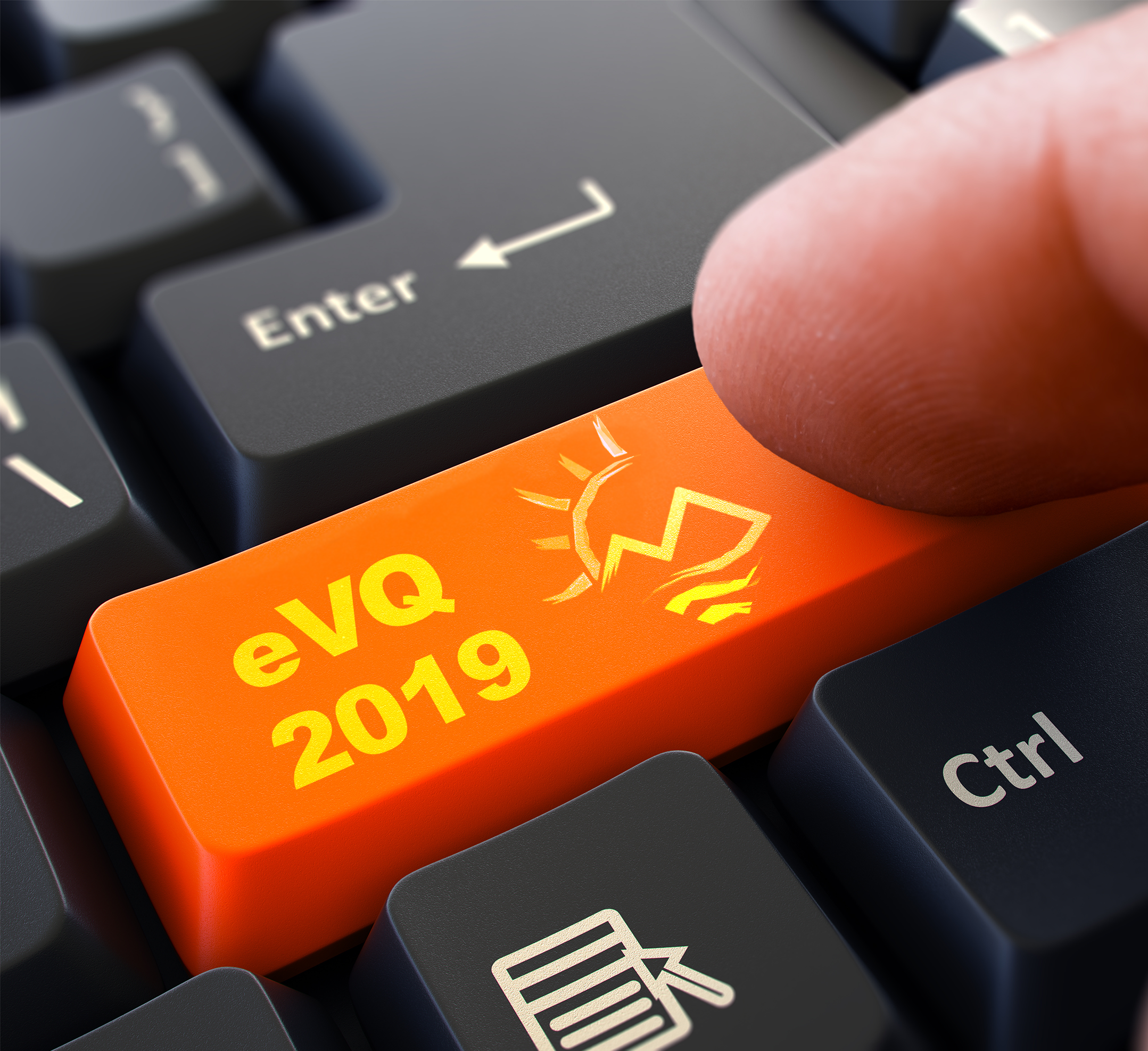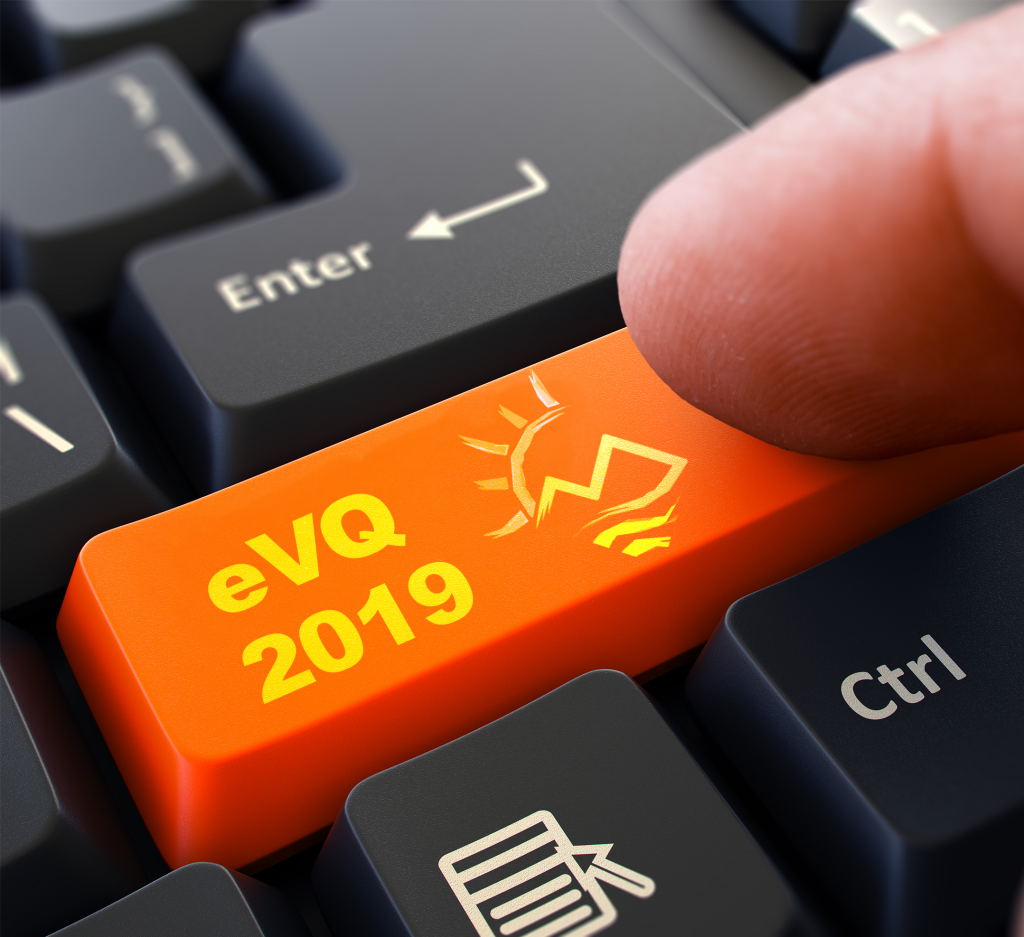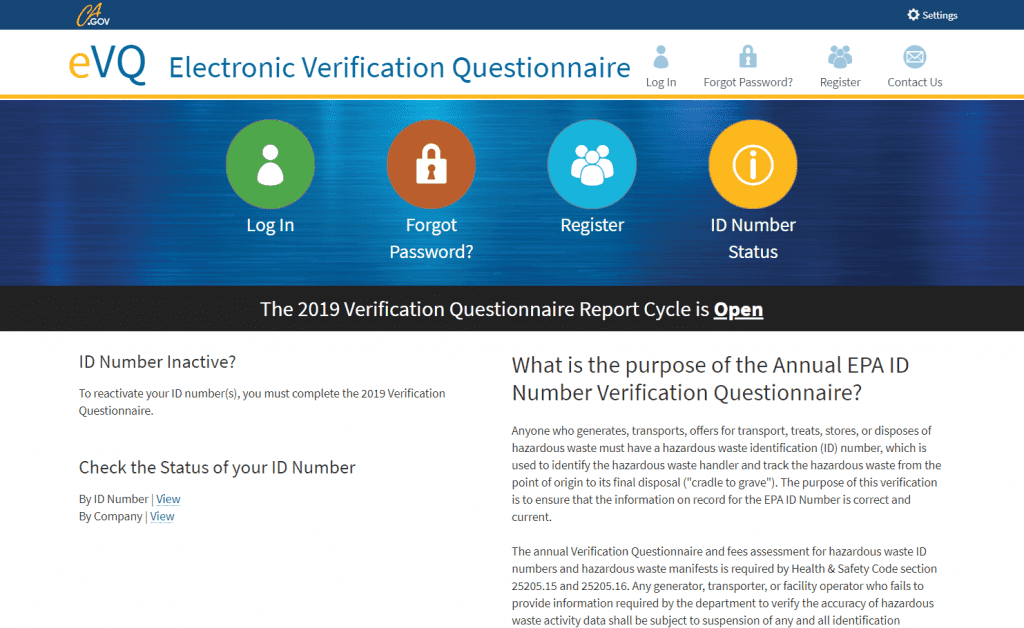
eVQ 2019: A Step-by-Step Guide to Compliance

Written by: Virginia McCormick, NES, Inc.

Hazardous waste generators must obtain and maintain the proper State and federal identification numbers.
eVQ Background
Any business that generates more than 100 kg of RCRA non-acute hazardous waste or more than 1 kg of RCRA acutely hazardous waste or that transports (or offers for transport), treats, or disposes of hazardous waste in the United States must have a federal Environmental Protection Agency (EPA) hazardous waste identification (ID) number. In California, any business that generates any amount or type of hazardous waste (RCRA [federal] or non-RCRA [State]) is required to obtain a site-specific ID number.
Businesses in California that generate 100 kg or less of RCRA non-acute hazardous waste or 1 kg or less of RCRA acutely hazardous waste must have a State ID number. State ID numbers are issued by the California Department of Toxic Substances Control (DTSC). Businesses in California that generate more than 100 kg of RCRA non-acute hazardous waste or more than 1 kg of RCRA acutely hazardous waste must have a federal EPA ID number, which is issued by federal EPA. For businesses in California that generate hazardous waste, their ID numbers (whether State or federal) must be verified annually to avoid deactivation. Verification is done through the Annual EPA ID Number Verification Questionnaire (eVQ).
Hazardous waste generator ID numbers are used to identify the handler, verify and impose applicable fees, and facilitate the tracking of hazardous waste from the point of origin to its disposal (“cradle-to-grave”). Ensuring that the ID information is correct helps protect the public and keeps the environment safe.
The reporting cycle for the eVQ is only open during a short period of the year, and the 2019 reporting cycle has been open since early September. Failure to obtain and/or maintain an ID number was one of the most common generator violations in 2018. Non-completion of the eVQ can result in a suspended EPA ID number, so it is important that hazardous waste generators, transporters, and facility operators are aware of their specific verification deadlines.
To learn more about California’s hazardous waste generator regulations, see the July 2019 NES article The DTSC Hazardous Waste Generators Program.

The eVQ homepage is located on the DTSC website and is the only place business owners should go to verify their information.
Accessing & Completing the eVQ
According to DTSC, any company in California that meets either (or both) of the following criteria must complete the 2019 eVQ:
- The company hazardous waste EPA ID number was active any time during the 2018/2019 fiscal year (July 1, 2018 – June 30, 2019)
- The company manifested hazardous waste using an assigned hazardous waste EPA ID number during the 2018 calendar year (January 1, 2018 – December 31, 2018)
When the eVQ cycle opens, an email notification is sent to ID number holders with active status any time during the previous fiscal year and/or that manifested hazardous waste any time during the previous calendar year. New ID number holders must register an eVQ account number before starting the questionnaire. Account registration requires a valid EPA ID number and a Federal Tax Identification Number.
The eVQ is due 30 days from when the ID number holder receives the first notification. If a company does not complete the 2019 eVQ within the 30-day deadline, its ID numbers may be revoked per California Health & Safety Code section 25205.16(c).
Step 1: Contact Information
After logging in with the company account information, the first step in the eVQ process is to verify contact information. This includes the contact person’s name, address, email, and phone numbers. This step is also where an alternate contact’s information may be inputted for a company.
Step 2: Company Information
This step verifies the company mailing addresses and owner information. The company’s name and owner’s name are grayed out in this step. If changes to the company’s name and/or the owner’s name are needed, an application must be submitted to idnumber@dtsc.ca.gov.
Step 3: EPA ID Number & Hazardous Waste Manifest Verification
After confirming the contact and company information is correct, the EPA ID number is verified, and the company’s hazardous waste manifest counts are populated. A hazardous waste manifest, commonly known as a Uniform Hazardous Waste Manifest or simply a manifest, is the document that must accompany shipments of hazardous waste from the time the waste leaves the handler’s location until it reaches its destination.
NES offers DOT Hazmat Employee training for employees who affect the safe transportation of hazardous materials and Uniform Hazardous Waste Manifest training for those who sign manifests as part of their job duties. Training is offered in both in-class and online formats; visit our transportation course listings page to view available programs.
It is the company’s responsibility to make sure that hazardous waste ID numbers are correct and that the manifest counts are accurate. This step is where a user may choose to either reactivate or inactivate an ID number.
Step 4: Fees Assessment
Using the company’s employee count, the number of relevant and permanent EPA ID numbers, and the manifest summary as confirmed earlier in the eVQ process, this step will calculate the applicable fees for the company. For a full fee structure as mandated by California Health & Safety Code section 25205.15, DTSC has published the 2019 Electronic Verification Questionnaire (eVQ) User Guide. If the user finds a manifest missing at this step, the manifest copy can be scanned and emailed to eVQ@dtsc.ca.gov.
Step 5: Fee Summary & Certification
The final step in the eVQ process is to review the fee assessment from the previous step and to complete the questionnaire. At this point, any of the previous steps can be accessed for changes. Changes need to be made before completing the questionnaire, as the user will not be able to go back after having saved the eVQ and flagged it as completed.
To complete the questionnaire, the user will type in the user’s name and title and then click “Save and Flag as Completed.” The user will receive an email confirmation stating the eVQ has been successfully completed. If the user does not click the “Save and Flag as Completed” button, the questionnaire will not show up as completed on DTSC’s end.
After completing the process, a printable invoice is generated. If fees are owed, the system will prompt a payment to be made either by check or credit card. It is recommended to print the invoice even if the company does not owe any fees. If changes are needed to the eVQ after step 5 is completed, assistance can be requested by emailing eVQ@dtsc.ca.gov.
Importance of the eVQ
The eVQ verifies that the information on record for the EPA ID number is correct and is used to collect State-mandated fees, which are calculated based on the number of hazardous waste manifests that were generated over the past year.
The eVQ plays an important role in California’s goal to track and regulate hazardous waste within the state. By providing a, “fast and convenient way” for hazardous waste handlers to complete the required annual verification and fees assessment, California can better identify and respond to potential environmental and public hazards.
Sites only have 30 days to report once they receive an email, and in 2019 DTSC has been sending out notification emails throughout the month of September. Hazardous waste generators in California should make sure their eVQ has been taken care of before the deadline is reached.
NES Training & Consulting
NES regularly provides a broad range of environmental health & safety training programs and consulting services on behalf of public and provide businesses throughout California and beyond. If your business requires assistance with hazardous waste compliance requirements or procedures, please contact NES at 916-353-2360 / 800-637-2384 or via email at office@nesglobal.net.
References:
DTSC Electronic Verification Questionnaire
Hazardous Waste ID Number Verification Questionnaire FAQ
2019 Electronic Verification Questionnaire (eVQ) User Guide
How to Avoid the Most Common Hazardous Waste Violations of 2018





